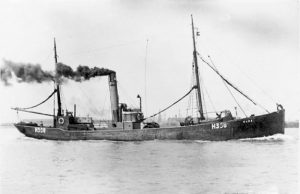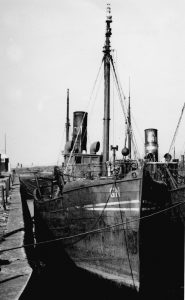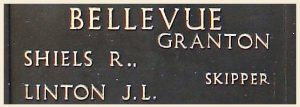Built by Mackie & Thomson at Govan in Glasgow (Yard No.154) and launched on 20th May 1897, the steel steam trawler Escort measured 104.2′ x 21.0′ x 10.7′ and her tonnage was 156 gross tons, 60 net tons. She was powered by a triple expansion steam engine by Muir and Houston Ltd., Glasgow delivering 45 registered horse power. Ordered by the Great Northern Steam Fishing Company of Hull (H365) she remained under Hull registry until 1922 with a brief spell requisitioned by the Admiralty during WWI. She was purchased by Mr David Pottie of Leith and registered at Granton (GN 90) in 1922 and renamed Bellevue. Following a number of ownership changes during the next 14 years, the Bellevue was purchased by her final owner John Horne of Cockenzie in February 1926 who passed management of the vessel to Thomas Scales Jnr of Newhaven, Leith.
The story behind the loss of the Bellevue was never fully publicised at the time of her loss due to wartime reporting restrictions and even now only a few scraps of information can be pieced together to form the basis of a story.
The Bellevue was working the west coast at the beginning of 1942 and left Ayr for the fishing grounds on Saturday 21st February with a crew of eight aboard. She was never seen again with the first indication that a tragic accident had occurred when, the following day, three bodies were washed ashore at Whiting Bay on the Isle of Arran
Archives of wartime casualties record the location of the Bellevue ‘off Turnberry’ but give no indication of the cause although a later review suggested war loss as a result of a mine.
The authors have located the wreck of a trawler approximately 3.5 miles west of Turnberry Lighthouse lying in 56 metres. The wreck, which has a corresponding beam measurement to Bellevue, also liberated a navigation lamp some years ago from a Leith maker. This, coupled with the Bellevue being the only recorded trawler lost in the vicinity, makes it a most likely candidate.
The wreck lies in position 55°19.399’N, 004°56.152’W with a least depth of 42m at the top of the bow post, with general seabed depths of 54 to 56m. The wreck is visually dramatic especially in good visibility. Lying oriented generally 130/310 degrees with stern pointing west, the hull rears out of the seabed from the engine room with bows pointing towards the surface with the deck sloping at least at 45 degrees. This unusual position could suggest that the vessel either hit or trawled up a mine, with the stern section being either blown off or certainly badly damaged, before sinking stern first and coming to rest pointing skyward.
The wreck is often blessed with good visibility but due to the depth and net across the bridge area and over the port side it is only for the experienced and suitably trained.
The loss of the Bellevue is commemorated by the Commonwealth War Graves Commission at Tower Hill on Panel 123, although strangely only two of the crew are listed; Robert Shiels and James Logan Linton. A full list of the 8 crew who lost their lives is listed below.
Robert Shiels – Skipper, age 46 of Edinburgh.
Thomas Blackie – Deckhand, age 61 of Port Seton.
Walter Dickson – Fireman, age 37 of St. Monans. Fife.
James Logan Linton – 2nd Fisherman, age 23 of Newhaven, Edinburgh.
John Leask- Cook, age 59.
Thomas Rutherford – Mate, age 62 of Edinburgh.
Alexander Harkess – 2nd engineer, age 51 of Cockenzie.
David Thomson – Chief Engineer, age 54 of Port Seton.
































